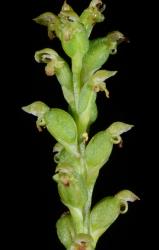- Taxon
- Gallery
- ≡ Ophrys unifolia G.Forst., Fl. Ins. Austr. 59 (1786)
- = Epipactis porrifolia Sw. (1800) nom. illeg.
- ≡ Microtis porrifolia (Sw.) R.Br. ex Spreng. in Sprengel, Syst. Veg., ed. 16 [Sprengel] 3, 713 (1826)
- = Microtis banksii A.Cunn., Curtis's Botanical Magazine (1835)
- = Microtis frutetorum Schltdl. (1847)
- = Microtis viridis F.Muell. (1866) nom. illeg.
- = Microtis longifolia Colenso, Trans. & Proc. New Zealand Inst. 17: 247 (1884 [1885])
- = Microtis papillosa Colenso, Trans. & Proc. New Zealand Inst. 18: 269 (1885 [1886])
Plant at fl.10–100 cm. tall. Stem erect, ± fleshy. Lf often overtopping raceme. Raceme occ. to 30 × 1 cm., us. smaller; fls few to ∞, us. almost touching throughout. Per. green. Dorsal sepal c. 3 mm. long, tip acute and us. slightly turned upwards; laterals shorter, acute, deflexed, tips sts tending to coil under. Petals ± under dorsal sepal. Labellum oblong, often narrowest about mid-length; tip truncate to emarginate, not apiculate though sts folded to appear so; margin papillose and us. also crenate and undulate; anterior callus variously developed, verrucose, often raised on a rounded ridge; large basal calli oval, prominent, us. continuous at sides with narrow band of callus behind transverse furrow which is slit-like, not pouched; labellum standing away from ovary at very narrow angle. Base of column about as broad as stigma; wings us. membr. throughout.
[From: Moore and Edgar (1970) Flora of New Zealand. Volume 2.]
Flowering: Oct.–Feb.




